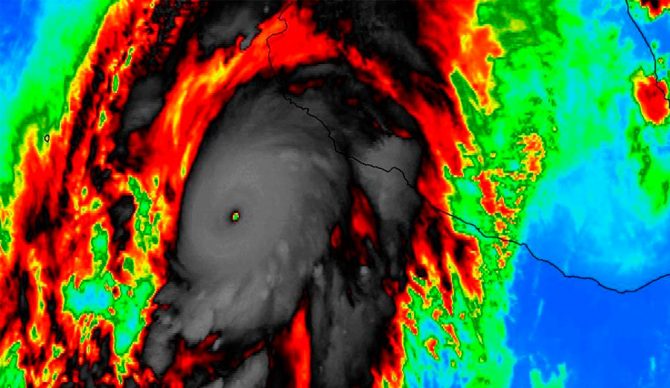
Hurricane Patricia, which hit Mexico, would have been a Category 6 storm… if that rating existed then. Image: NOAA
Atlantic hurricanes are increasing in intensity by an entire category, according to climate researchers. The cause probably won’t come as a surprise, either: it’s us.
“Human-caused climate change is boosting the intensity of Atlantic hurricanes by a whole category on the Saffir-Simpson Hurricane Wind Scale,” Science News wrote. The Saffir-Simpson Hurricane Wind Scale rates hurricanes based on their peak sustained wind speed.
According to the research, maximum wind speeds of hurricanes jumped up an average of 18 miles per hour from 2019 to 2023.
It makes sense, if you have a basic understanding of how hurricanes work. Four ingredients are necessary: warm water, low air pressure, warm, moist air, and low wind shear.
“When humid air is flowing upward at a zone of low pressure over warm ocean water, the water is released from the air, creating clouds that grow into a strong storm,” the Center for Science Education explained. “As it rises, the air in a hurricane rotates. Air drawn into the center of a hurricane curves to the right in the Northern Hemisphere and toward the left in the Southern Hemisphere due to the Coriolis effect — a phenomenon in which winds curve because of the Earth’s rotation.”
If there is a continuous supply of energy from warm ocean water and that warm, wet air, you’ve got the recipe for a tropical storm. If the storm moves over areas with warmer water, they get stronger. Colder water or land generally slows them down, which is why they release so much rain once they hit land.
But as climate change warms the planet — especially at the equator — ol’ Mother Nature is trying to redistribute that heat to even things out a bit. With all that in mind, researchers wanted to get a closer look at just how much the changing climate was affecting storms.
“Drawing from historical sea surface temperature records that stretch back over a century and computer simulations of Earth’s climate, the researchers generated simulations of the modern North Atlantic Ocean in a world without climate change,” Science News continued. “They then calculated what the wind speeds of recent hurricanes would have been over these cooler Atlantic Oceans, and finally compared the hypothetical speeds to observed hurricane wind speeds.”
Of the 38 hurricanes that hit from 2019 to 2023, 30 of them them “reached intensities roughly one category higher because of climate change.”
The researchers found that two Category 5 hurricanes in 2024 wouldn’t have become stronger than a Category 4 if not for human-caused climate change. They’re not just getting stronger, either. Climate change is “now allowing very intense storms to persist later into the season,” according to Climate Central’s Daniel Gilford, a climate scientist based in Florida.

